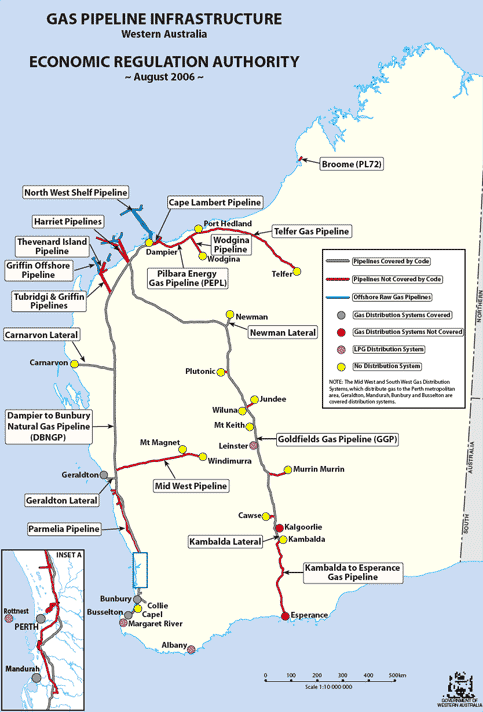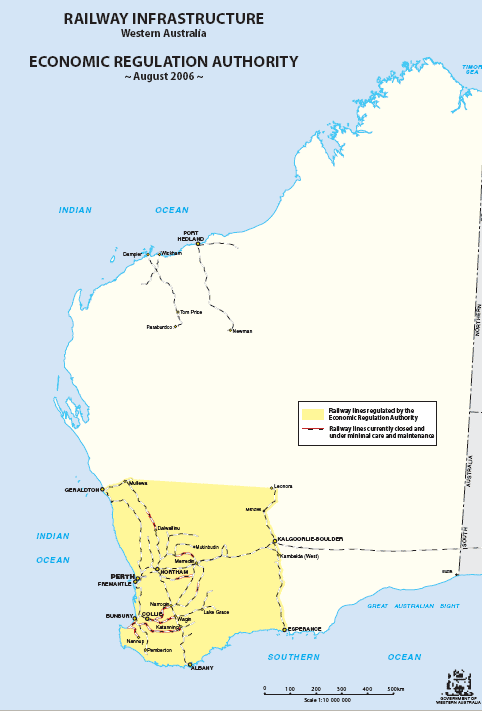- The Authority is to complete the assessment of access arrangements and revisions to access arrangements.
- Proposed revisions to the access arrangement for the Tubridgi Gas Pipeline are scheduled to be lodged for assessment on 2 February 2006
- A Final Report on the review of the Gas Marketing Code of Conduct is expected to be issued in late 2005.
Divisional Operations – Key Deliverables and Achievements
Gas and Rail Access Division — Gas Access Functions
Objectives
Under the National Third Party Access Code for Natural Gas Pipeline Systems –
- To regulate third party access to gas transmission and distribution pipelines in Western Australia which are subject to regulation under the Code, namely the Dampier to Bunbury Natural Gas Pipeline, the Goldfields Gas Pipeline, the Mid–West and South–West Gas Distribution Systems and the Kalgoorlie to Kambalda Pipeline.
Under the Energy Coordination Act 1994 –
- To approve and amend gas retail market schemes.
- To monitor and enforce compliance with the Gas Marketing Code of Conduct 2004.
- To amend or replace the Gas Marketing Code of Conduct 2004.
Key deliverables and achievements
What we set out to do…
In its 2004–05 Annual Report, the Authority committed to the following work:
What we achieved…
- The Authority completed the assessment of access arrangements and revisions to access arrangements for three of the four regulated gas pipelines in Western Australia, namely the Dampier to Bunbury Natural Gas Pipeline, the Goldfields Gas Pipeline and the Mid–West and South–West Gas Distribution Systems. The owner of the Kalgoorlie to Kambalda Pipeline is yet to lodge a proposed access arrangement for the Authority's consideration.
- The Western Australian Minister for Energy made a decision to revoke coverage of the Tubridgi Pipeline System effective from 1 May 2006. This meant that third party access to the Tubridgi Pipeline System was no longer regulated by the Authority and as a result, a review of the access arrangement for this pipeline was not required.
- The release of the Final Report on the review of the Gas Marketing Code of Conduct 2004 is now expected to occur in late 2006 to provide a longer period for interested parties to respond to the interim reports than previously anticipated.
More specifically, the following key achievements were accomplished in the area of gas access:
- On 15 December 2005 the Authority issued its Further Final Decision and Final Approval on the revisions proposed to the access arrangement for the Dampier to Bunbury Natural Gas Pipeline. The Further Final Decision of the Authority was to not approve the proposed revised access arrangement submitted by DBNGP (WA) Transmission Pty Limited. Subsequently, the Authority drafted and approved its own access arrangement for the pipeline, which came into effect on 30 December 2005.
- Significant progress was made toward finalising the assessment of a section 8.21 application on the proposed capital expenditure for the stage 5 expansion of the Dampier to Bunbury Natural Gas Pipeline.
- The Further Final Decision and Final Approval of the revised proposed access arrangement for the Goldfields Gas Pipeline was published on 14 July 2005. The Authority's decision was to approve the revised proposed access arrangement submitted by Goldfields Gas Transmission Pty Ltd on 17 June 2005. The access arrangement commenced on 1 August 2005.
- The Further Final Decision and Final Approval for the AlintaGas Networks Pty Ltd revised access arrangement for the Mid–West and South–West Gas Distribution Systems was issued on 10 August 2005. The decision was to approve the proposed revised access arrangement, which came into operation on 25 August 2005.
- Significant progress was made toward finalising a review of the Gas Marketing Code of Conduct 2004, which is expected to be completed in the second half of 2006.
- A number of rule changes associated with administering the Retail Energy Market Company (REMCo) Retail Market Scheme were considered and approved.
- Gas market participants' compliance with the obligations set out under the gas Retail Market Scheme was monitored.
Gas and Rail Access Division — Rail Access Functions
Objectives
Under the Railways (Access) Code 2000 –
- To regulate third party access to railways in Western Australia which are subject to regulation under the Code.
Key deliverables and achievements
What we set out to do…
In its 2004–05 Annual Report, the Authority committed to the following work:
- Finalisation of the Report on the Rail Code Review expected in September 2005.
- Following release of the Final Report on the Rail Code Review, provide assistance to the Department of Treasury and Finance to prepare the relevant amendments to the Code.
- Monitor the performance of railway owners in meeting required service standards.
- Monitor the methodology and input parameters to calculate the weighted average cost of capital (WACC) prior to the next determination on 30 June 2006.
- Ensure that any findings of non–compliance associated with the audit scope of work are rectified.
- Review the Over–payment Rules and Costing Principles to ensure that they are fair to both the railway owner and access seeker.
- Monitor the cost allocation methodologies to see what occurs in other jurisdictions and elsewhere in the rail industry.
- Provide recommendations to the Authority on the Review of Methodologies for the allocation of Common Costs, which is expected by the end of September 2005.
What we achieved…
- The Final Report on the review of the Railways (Access) Code 2000 was provided to the Minister on 23 September 2005 and released on the Authority's website on 5 December 2005.
- The Department of Treasury and Finance is currently considering the Authority's recommendations in its Final Report on the review of the Railways (Access) Code 2000. Following this, the Authority will help the Department prepare the relevant amendments to the Code.
- The Authority has monitored the performance of railway owners in meeting required service standards. Reports on the annual key performance indicators for WestNet Rail and the Public Transport Authority for the 2004–05 financial year were published on the Authority's website.
- The Authority has confirmed with WestNet Rail that one item of non–compliance, identified in the performance audit for WestNet Rail, would be rectified.
- In December 2005, the Authority began a review of WestNet Rail's Costing Principles, Over–payment Rules, Train Management Guidelines and Train Path Policy. Following extensive public consultation the review was expected to be completed in August 2006 resulting in amendments to WestNet Rail's four policy documents.
- The Authority established a working group of interested stakeholders to assist with the review of methodologies for allocating common costs in the rail industry. Following the review of methodologies in other jurisdictions, the working group recommended that train control costs to be directly attributed to rail lines. The new cost allocation methodologies will be reflected in future reviews (expected to commence in September 2006) of floor and ceiling costs for rail lines.


